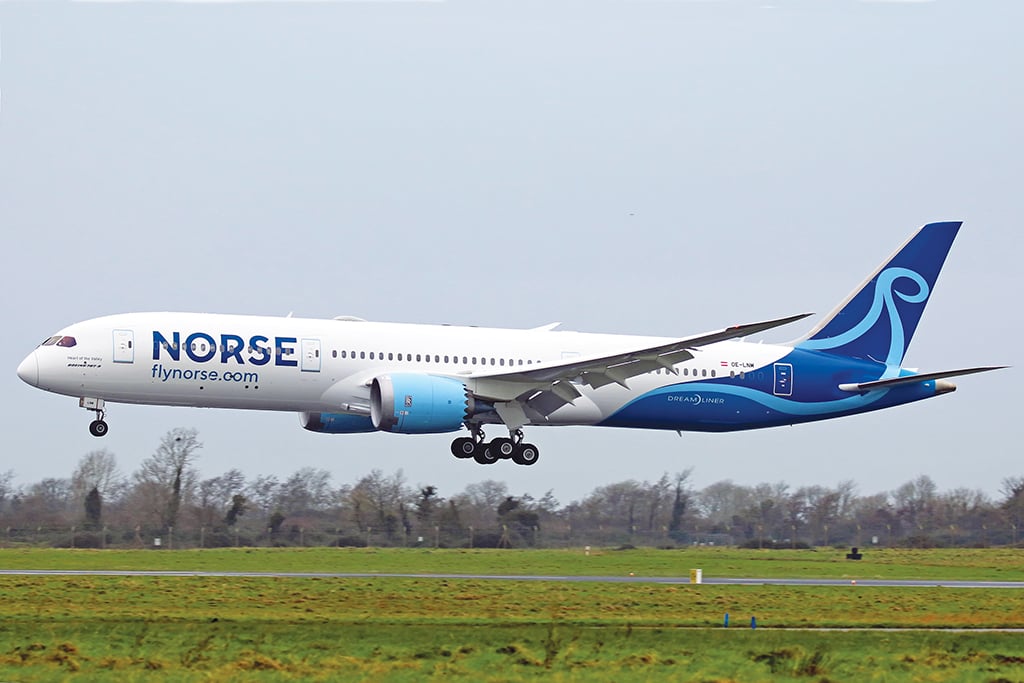
Iceland’s Play offers one-stop service between Europe and North America.
The share of low-cost seats on routes between Europe and North America was about 4% during the first quarter of 2023—only two years after falling to zero.
While it may still not seem like a lot, the only time the figure was above 6% was in 2018, when Oslo-based Norwegian and defunct Icelandic operator Wow air were at their most bullish, adding large amounts of capacity in a bid to disrupt a market dominated by immunized joint ventures.
However, much has changed since then. Wow’s demise in 2019 was followed by Norwegian’s exit from transatlantic routes during the pandemic as the Scandinavian LCC opted to focus on its core domestic and European operations in a bid to improve finances.
But with change comes opportunity—and two startups are hoping to succeed where previous LCCs have failed. Play is building a hub-and-spoke network out of Reykjavik Keflavik, offering a one-stop connecting strategy between Europe and North America, while Norse Atlantic Airways is taking a more direct approach, flying nonstop from European capitals to New York and Florida.

So, can either avoid the pitfalls that hampered Wow and Norwegian? Although a number of Play’s senior management team were previously employed by Wow—and there is overlap in terms of the carriers’ route networks—CEO Birgir Jónsson said his airline is taking a more measured approach.
He pointed out that Wow was underfunded in relation to its size and overcomplicated its operations by adding A330s, as well as flying longer routes to the likes of Los Angeles and Delhi. Play, which began commercial operations in July 2021, has so far focused on connecting primary and secondary European points with the east coast of the US using Airbus A320neos and A321neos.
“We expect to have a strong summer travel season,” Jónsson told ATW. “Flight operations from the US contributed to our increase in passenger load in 2022, and we flew over 780,000 passengers on more than 5,400 flights throughout the year.
“This was a strong performance for our expanded operations and in line with our target for the year, with Play’s load factor for 2022 reaching 79.9%—a 50% increase between 2021 and 2022.”
About 40% of Play’s traffic connected through Reykjavik during December 2022 and the airline expects a similar figure in 2023. Adding to its existing North American network of Boston (BOS), Baltimore (BWI) and New York Stewart (SWF), service to Washington Dulles (IAD) starts in April and its first Canadian route—to John C. Munro Hamilton (YHM) near Toronto—
will begin in June.
Other new routes for the summer season include flights to secondary European points like Aalborg, Aarhus and Billund in Denmark. Jónsson said these additions are part of efforts to “connect passengers to unique tourist destinations or destinations with strong commerce and trade industries.”
Norse
While Play has adopted a one-stop approach across the north Atlantic, rivaling Icelandair and following the void left by Wow, Norse Atlantic’s model is more closely aligned to Norwegian’s transatlantic foray.
The LCC began flying in June 2022, initially connecting Oslo with New York JFK and Fort Lauderdale (FLL) using former Norwegian 787s on leases with favorable terms.
Norse’s European network has evolved to include London Gatwick (LGA) and Berlin (BER), with service from Paris Charles de Gaulle (CDG) and Rome Fiumicino (FCO) starting in March and June, respectively.
CEO Bjørn Tore Larsen told ATW that further North American destinations would be added this year but stressed the carrier was “not in a rush to jump into new markets,” preferring to concentrate on growing existing routes.
He also distanced the airline from Norwegian’s transatlantic efforts, highlighting that Norse does not operate a hub-and-spoke model and is flying only widebodies. It is also targeting large catchment areas instead of trying to stimulate smaller ones with less competition.
“Rather than try to create demand that’s not there, we want to provide good competition on popular routes,” Larsen said. “There’s nothing magic to it—we are flying thick markets that welcome the type of product that we have.”
Between Paris and New York, capacity during peak summer this year will be about 65,000 weekly nonstop seats—up by 8% on the same week in 2019. Capacity between Rome and New York—the second new sector Norse is entering this year—is also scheduled to be 16% higher.
“Competition is great for customers, and it is great for us because we have to make sure we are as equally good or better,” Larsen said. “We haven’t been exclusive on any routes, but we know there is huge demand across the Atlantic, particularly in the summer.”
Although Play and Norse each have echoes of long-haul LCCs past, Jónsson and Larsen make it clear that lessons have been learned. Neither will be expanding with the same gusto that contributed to Wow and Norwegian’s exit from the transatlantic space.
“Some routes have performed above expectations, and some have disappointed a little,” Larsen said. “But the demand for a low-cost transatlantic product is there—we just have to take it one step at a time.”





